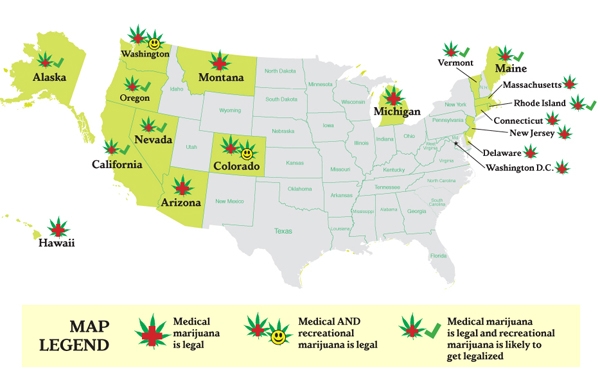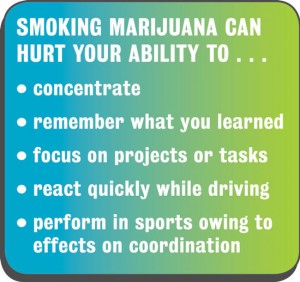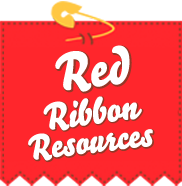In our last article entitled Should The USA Legalize Marijuana, we presented the two sides of the argument with quotes and philosophies from varied sources. Here at Red Ribbon Resources our position is no to Marijuana legalization. We’re advocates of keeping recreational drugs in general, and Marijuana in particular out of the hands of kids and teenagers. Our position isn’t rooted in moral principles, but rather the chilling statistics that every parent, teacher, professional counselor, kid and teenager should be aware of. According to Wikipedia, the use, possession, sale, cultivation, and transportation of cannabis (marijuana) in the United States under federal law is illegal, but the federal government has announced that “if a state wants to pass a law to decriminalize cannabis for recreational or medical use they can do so, but they need to have a regulation system in place.”
The substance is listed as a Schedule I under the Controlled Substances Act of 1970, which means that the substance has been decided by the federal government to have both high abuse potential and no established, safe medical use.
Many states have decriminalized the substance to varying degrees, while others have created exemptions specifically for medical use; only Colorado and Washington have legalized the recreational use of Marijuana, following the approval of state referendum in the 2012 elections.
There were similar ballot measures in Oregon and California where it narrowly failed. Colorado was the first state where the use of marijuana was legalized on November 6, 2012 through Article 18, section 16 of the state constitution, for adults 21 and older, with Washington state following shortly thereafter. The specifics of the legalization vary from state to state. For example, in Colorado each household can grow up to six marijuana plants; in Washington state home-growing marijuana plants are banned. Currently 4 states have decriminalized possession laws, and 9 have decriminalized possession laws and allow legal medical use.  By the legalization of Marijuana for adults however, it set the stage for teens to want to emulate them — in the same way that many teens drink: they think it makes them appear more adult-like, and in some cases ‘cooler’ to their peers.
By the legalization of Marijuana for adults however, it set the stage for teens to want to emulate them — in the same way that many teens drink: they think it makes them appear more adult-like, and in some cases ‘cooler’ to their peers.
However, Marijuana today is a far different substance than it was in the 1960’s and ’70s at the height of the hippy movement. THC (an active ingredient in Marijuana) levels have increased from 3% then to as much as 15% currently, and the fall out of that is highly impacting. And not in a good way. Colorado is seeing student statistics that are alarming.
Teenagers are the most affected age group by this legalization, due in part to curiosity, peer pressure, and escapism. In Colorado, drug-related crime, car accidents and other issues have risen, while tourism in this — and other — states has dropped.
What People Say About the Marijuana Legalization
Governor Jerry Brown in an interview with NBC stated that he did not think the legalization of marijuana will help build the foundation of a great state or nation. He added that in a world with increasing competition to succeed, that this legalization policy may hamper a user’s’ level of mental awareness that is necessary in order to be successful. And he urged the states with legalized drug policies to share statistical impact information with other states.
Marijuana Use on the Rise with Teenage Students
Mike Dillon has worked in Colorado as an undercover officer with a drug task force and has seen a shocking rise of Marijuana use in schools recently. Dillon is now a school resource officer and he is shocked at the regular use he sees by teenagers. And Colorado school resource officers, nurses, staffs, counselors — and officials with Colorado school safety and disciplinary programs — are reporting an increased number of marijuana-related incidents in schools and among teenagers.
Based on statistical data, consuming this drug regularly has a negative impact on a students’ ability to progress and develop in different areas. These include emotional development, academic retention, social interactions and many more.
In an article in Psychology Today, they noted that researchers at Northwestern  Medicine “discovered that the developing teenage brain may be particularly vulnerable to excessive marijuana use. The researchers found that teens who smoked marijuana daily for about three years had abnormal changes in their brain structures related to working memory and performed poorly on memory tasks. And they also found that –years after the subjects ceased the use of Marijuana — memory-related structures in their brains appeared to shrink and collapse inward, reflecting a possible decrease in neuron volume. These findings indicate that there could be long-term detriments of chronic marijuana use as a teenager.”
Medicine “discovered that the developing teenage brain may be particularly vulnerable to excessive marijuana use. The researchers found that teens who smoked marijuana daily for about three years had abnormal changes in their brain structures related to working memory and performed poorly on memory tasks. And they also found that –years after the subjects ceased the use of Marijuana — memory-related structures in their brains appeared to shrink and collapse inward, reflecting a possible decrease in neuron volume. These findings indicate that there could be long-term detriments of chronic marijuana use as a teenager.”
Red Ribbon Resources is deeply concerned over these and other findings. The brain of a child or teenager is still in the development stages, and these studies show that Marijuana use stunts and alters that development. According to numerous studies, Marijuana is the second most used drug by teens after alcohol, and research and statistics are showing that:
- students who use marijuana frequently have a lower intellectual brain function than nonusers,
- marijuana has negative impact on attention, learning level and memory,
- daily usage students score lower grades and many of them drop out of college,
- College students addicted to marijuana spend more time in clubs, parties and less time in studying, according to a Harvard study,
- the long term use of marijuana may cause “amotivational syndrome,” a mental state that inhibits their motivation to excel in career, personal and academic goals, and that
- Marijuana depletes cash resources that could be spent on more productive things.
Studies have shown a rise in marijuana use among 12th grade students, and that 10th graders and 8th graders are also smoking. Based on surveys in Colorado, 8th, 10th and 12th grader use has steadily risen during the past few years as shown in the chart below.
| 2010 | 2011 | 2012 | 2013 | |
| 12th Graders | 43.80 | 45.50 | 45.20 | 45.50 |
| 10th Graders | 33.40 | 34.50 | 33.80 | 35.80 |
| 8th Graders | 17.30 | 16.40 | 15.20 | 16.50 |
But more alarmingly — and certainly something legalization contributes to –, according to Llyod Johnston, principal investigator of the Monitoring The Future Study at the Institute for Social Research at Michigan University, “One important variable that has been a lead indicator of use—namely the amount of risk teenagers perceived to be associated with marijuana use—continued its sharp decline in 2012 among teens, which would suggest further increases in use in the future.”
More reasons for alarm:
- A synthetic cannabinoid product named Smacked! has been linked to at least 41 overdoses in New Hampshire since August 11, leading the governor of that state to declare a State of Emergency. Read More
- New York City issued a public warning in late July after an increase in emergency room visits related to synthetic cannabinoids. Read more.
As we approach Red Ribbon Week, the national drug awareness and education initiative begun after the brutal torture and murder of D.E.A. agent Enrique “Kiki” Camarena in 1985 (formally recognized in 1988), parents should make time to have conversations with children before the age of 13 (and older) to provide access to information and statistics that shed light on the realities of Marijuana use.
As kids get into their teenage years headed towards adulthood, telling them what to do is less impacting than educating them — providing the necessary information so that they (the teens) can make good choices when faced with peer pressure, loneliness or other emotional vulnerability that will impact the rest of their lives.
In 2012, an estimated 23.9 million Americans aged 12 or older—or 9.2 percent of the population—had used an illicit drug or abused a psycho-therapeutic medication (such as a pain reliever, stimulant, or tranquilizer) in the past month. This is up from 8.3 percent in 2002. The increase mostly reflects a recent rise in the use of marijuana, the most commonly used illicit drug — according to theNational Institute on Drug Abuse, NIDA
6 Important Statistics of Teens using Marijuana are:
- 6 times higher than the teens addicted to other illegal drugs. NIDA
- negatively impacted in learning processes. Substance Abuse and Mental Health Administration.
- 4 times more likely to report “D” grades.
- Negatively impacted in the areas of mental health problems.
- Suffer with increased anxiety and depression.
- Are more susceptible to addiction due to increased levels of THC
Inform kids and teens about the proven realities of Marijuana use; it’s not the fun recreational drug it is thought to be. We at Red Ribbon Resources believe that in today’s digitally-wired world, kids and teens have become more independent, and proactive about their lives and “Just Say No” is no longer the sole deterrent it once was.
While we need to continue to present strong visual reminders to stay drug free, we also — as guardians of our children’s futures — have the responsibility as parents to provide as much information as possible. With information, parent guidance and engagement, teenagers can DECIDE not to use Marijuana, rather than avoid it solely out of fear of their parent’s wrath, because kids are just no longer driven by parents’ will alone.
RESOURCES
Heavy marijuana users have abnormal brain structure and poor memory Teen Marijuana Use and Medical Marijuana laws How Marijuana Affects a Teen’s Developing Brain research-shows-negative-effect-marijuana-has-on-development-of-teens Marijuana use and college students impact how-does-marijuana-use-affect-school-work-social-life
Originally posted 2014-09-09 03:49:57. Republished by Blog Post Promoter

Pingback: Redribbonresources (redribbon225) | Pearltrees